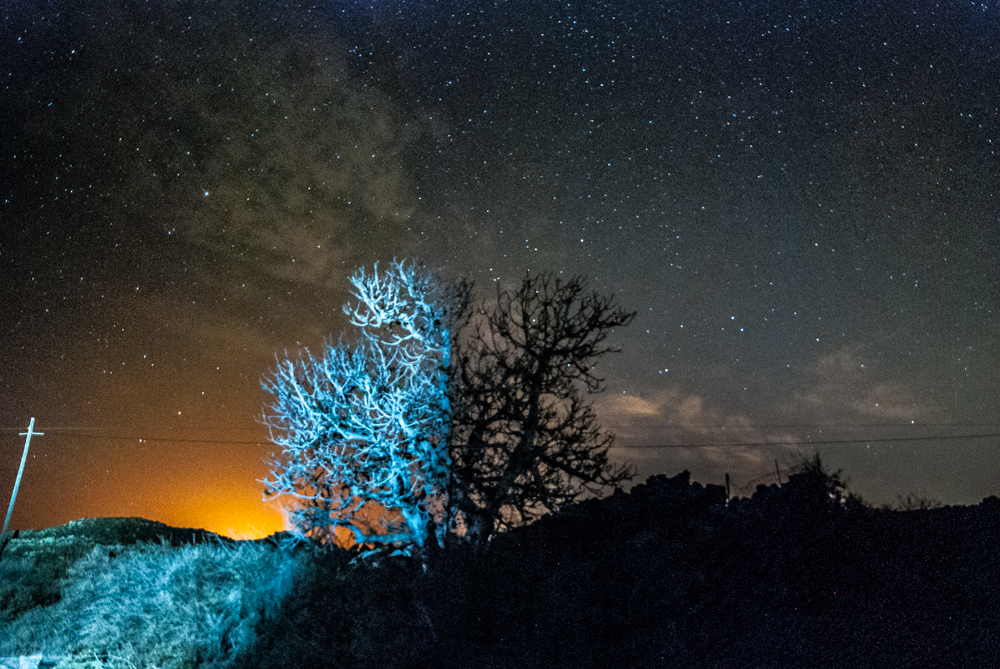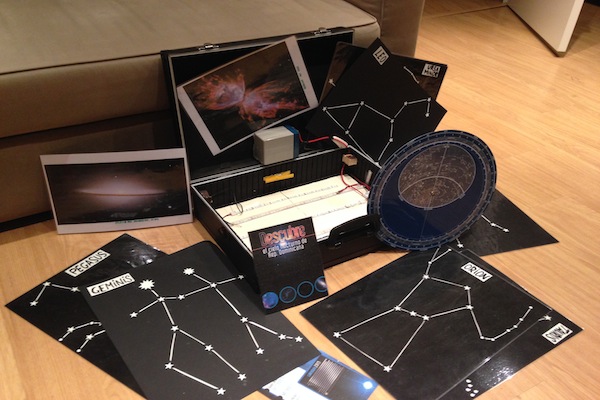.... Iñaki is the latest member of the team at StarsbyNight. Inaki's storytelling, knowledge and charisma capture the audience as he enlightens the night with his light shows and unusual locations to tell us all about the night sky. Come and join him in Spanish on Sunday nights, or in English on Tueday nights.
Tell me, what is the difference between an Astronomer and a Star Guide?
An astronomer is a person who is dedicated to the science and physics of his profession. Imagine! This is not me! I have a basic knowledge of Astronomy and recognise the different places in the night sky. Simply, I enjoy sharing my knowledge with people, in a friendly and fun way. My passion is my job and I love it!
What started your interest in the night sky?
From a young age I liked to stop and observe the stars, but the first time I began to understand the constellations and how to orientate myself by the stars was whilst I was on a survival course in the wild.
Where are you from?
I was born in Benicasim, a small village on the east coast of Spain, just above Valencia.
What attracted you to Fuerteventura?
I was in Nicaragua, when a friend told me that Fuerteventura had good waves for surf and good wind for kiting. I checked online and discovered that the island is also a Starlight Reserve!! In a few days I had bought my plane ticket and I am here!
What can you see in Fuerteventura in the sky?
The great thing about Fuerteventura is the clear skies and if you move away from the urbans centres where there is little light pollution than you can enjoy the starry skies that are not easy to find anymore!
Where else/other countries have you been teaching people about the night?
I created my own way of communicating to the people about the stars above in Andalusia, Dominican Republic, Nicaragua and Honduras.
Have you gone anywhere unusual?
I have visited some 30 countries till now; Asia, Africa, Europe and the Caribbean, different islands in the Indian Ocean and Central and North America….many beautiful places, always travelling with my rucksac, but unusual? My travels are quite normal for a person who is accustomed to travel, we are all on planet Earth. I would like one day to see planet Earth from Space. hahaha.
What are constellations?
The sky is divided into 88 parts and each of these parts forms a group of stars that we call constellations. The oldest civilsations named these constealltions after an animal or person (some need more imagination than others), to make it easier for the people to remember them. They are also a great point of reference for astrnomers of all epcos, even today.
Imagine that I ask you where is Madrid. Well, the answer will be in Europe, and in Spain more specifically.
Now, if the question is where is the Galaxy M31, also known as Andromeda. Well you must look to the part of the sky where you will find the Adromeda constealtion and M31 is specifically situated close to the star Andromeda. Like this all astrnomers know the place in the sky that they are looking for.
How many constellations are there?
There are 88 different constellations between the northern and southern hemisphere. In the northern hemisphere, the most common visible are the Ursa Major and Ursa Minor. These constealtions are visible throughout the whole year. The Ursa Major is very easy to recognize as it’s stars are very bright, compared to Ursa Minor that has less bright stars, however, it does have our main star, Polaris, the polar star that always shows the north.
Do you need a telescope to see the night sky?
No, the only thing necessary is that we learn and enjoy the night sky with our eyes. Other tools, like telescopes and binoculars help us to observe deeper space objects that we find further away or less bright. But to start with this view is more than sufficient.
Any funny stories that you can tell us?
I remember when travelling with my equipment that I have created to share astronomical information, a briefcase with strange lights. I would always cause a stir at the airports, with security thinking I had some kind of bomb. It always ended well with a little display of how my materials work capturing the interest of everyone around. In the Dominican Republic I even bumped in to one such “observer”. It was my briefcase that he remembered! We become good friends.
Thanks Iñaki
..
Iñaki es el último miembro del equipo de StarsbyNight. Iñaki de la narración, el conocimiento y carisma capturar a la audiencia mientras se ilumina la noche con sus espectáculos de luz y lugares inusuales para contarnos todo sobre el cielo nocturno. Venir y unirse a él en español domingos por la noche o en Inglés martes por la noche.
¿Dime cuál es la diferencia entre una guía de astronomía estrella?
Un astrónomo es una persona que se dedica a la ciencia o física de forma profesional…imagino! Yo no soy nada de eso,tengo conocimientos básicos sobre astronomía y reconozco los diferentes lugares en el cielo nocturno. Simplemente disfruto compartiendo mis conocimientos con la gente común de una forma agradable y divertida así que mi pasión se ha convertido en mi trabajo, y me encanta!
¿Lo que comenzó su interés en el cielo nocturno?
Desde pequeño me ha gustado pararme a observar las estrellas pero la primera vez que comencé a entender sobre las constelaciones fue durante un curso de supervivencia en la naturaleza, ahí nos enseñaron a orientarnos por las estrellas.
¿De donde eres?
He nacido en Benicasim, un pequeño pueblo en la costa este de España, justo por encima de Valencia.
¿Lo que atrajo a Fuertenventura?
Estaba en Nicaragua y un chico al que conocí me dijo que en Fuerteventura había buenas olas para surfear y buen viento para hacer kite, luego miré en internet y vi que era una reserva Starlight. En pocos días compré el billete de avión y aquí estoy.
Qué se puede ver en Fuerteventura en el cielo?
Lo bueno que tiene Fuerteventura son sus cielos despejados y si te alejas un poco de los centros urbanos la poca contaminación lumínica te deja disfrutas de unos cielos estrellados que no es fácil de encontrarlos.
¿En qué otro / otros países lleva enseñando a la gente acerca de la noche?
He realizado actividades de observación de estrellas en Andalucía, República Dominicana, Nicaragua y Honduras.
¿Ha ido a cualquier lugar inusual?
He visitado unos 30 países hasta ahora. He visitado Asia, Africa, Europa, el Caribe, diferentes islas en el océano Índico, Centro américa y norte america…muchos lugares bonitos, siempre viajando con mi mochila pero…inusual? Bastante usuales para una persona que está acostumbrada a viajar, eso sí, todos ellos dentro del planeta tierra, me encantaría un día poder ver la tierra desde el espacio, jajaja.
¿Cuáles son las constelaciones?
El cielo está dividido en 88 partes y cada una de esas partes la forma una agrupación de estrellas a la que llamamos constelación. Las antiguas civilizaciones les han dado la forma de algún objeto o persona, (eso sí, con mucha imaginación) característica así es más fácil para la gente de recordarla. Y sirve a los astrónomos para saber dónde mirar en el cielo.
Imaginen que os pregunto donde está Madrid. Pues la respuesta sería en el continente Europeo y en España más concretamente.
Ahora si os pregunto dónde está la galaxia M 31 (también conocida como galaxia de Andrómeda). Pues debéis mirar al lado del cielo donde se encuentra la constelación de Andrómeda y más concretamente cerca de la estrella μ Andromedae. Así los astrónomos saben a que lugar del cielo deben observar para encontrar el objeto en concreto.
¿Cuántas constelaciones?
En el cielo existen 88 constelaciones diferentes entre el hemisferio norte y el hemisferio sur. En el hemisferio norte es posible que la más común sea la de la Osa Mayor y la Osa Menor. Son constelaciones que podemos ver a lo largo de todo el año. La Osa Mayor es muy fácil de reconocer ya que todas sus estrellas son muy brillantes y las estrellas de la Osa Menor son menos brillantes pero su estrella principal es Polaris, la estrella polar, que siempre nos señalará el norte.
¿Necesita un telescopio para ver el cielo nocturno?
Nada de eso, lo único que necesitamos para aprender y disfrutar el cielo nocturno son nuestros ojos. Otras herramientas como telescopios o prismáticos nos ayudarán a ver objetos que se encuentran más lejos o son menos brillantes. Pero para comenzar con nuestra vista es más que suficiente.
¿Alguna historia divertida que nos pueden decir?
Pues recuerdo que cuando viajaba con mi material para divulgar información sobre astronomía tenía un maletín con unas luces un poco peculiar. Y en los aeropuertos siempre me paraban pensando que era una bomba o algo raro, siempre tenía que hacerles una pequeña exposición sobre la actividad y la gente de aduana terminaban muy interesados. Incluso una vez, en República Dominicana, coincidí en un restaurante dos meses después de pasar por el aeropuerto con un hombre que me reconoció tras verme en el aeropuerto haciendo la exposición en la aduana. El hombre me dijo, ¿tu viajas con un maletín muy raro verdad? Nos hicimos buenos amigos.
Gracias Iñaki.
....




















